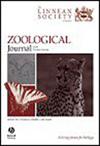斯堪的纳维亚北极狐(Vulpes lagopus)的时间基因组变化
IF 2.8
2区 生物学
Q1 ZOOLOGY
引用次数: 0
摘要
人口数量下降对种群生存能力有重要影响,因为它们可能导致基因组多样性的丧失,以及近亲繁殖和有害突变的表达增加。在更新世/全新世过渡时期,北极狐(Vulpes lagopus)在斯堪的纳维亚定居,此后其种群一直处于全球分布的边缘。由于人类的迫害,斯堪的纳维亚人口在20世纪初变得更加分散,并在20世纪80年代经历了进一步的下降。我们从瓶颈前以及现代斯堪的纳维亚和俄罗斯样本中获得了高覆盖率的基因组,发现与西伯利亚人群相比,斯堪的纳维亚人群的基因组多样性更低,近亲繁殖更高,甚至在历史瓶颈之前,这很可能反映了斯堪的纳维亚人群长期的部分隔离和最近的冰川后起源。南部亚种群近亲繁殖水平最高,可能是由于最近才发现和高度孤立。我们的研究结果还表明,尽管近亲繁殖在过去的一个世纪中大幅增加,但总遗传负荷的数量并没有改变。总的来说,这些发现说明了时间方法的效用,以解开古代生物地理过程中最近衰退的基因组后果。本文章由计算机程序翻译,如有差异,请以英文原文为准。
Temporal genomic change in the Scandinavian Arctic fox (Vulpes lagopus)
Demographic declines have important consequences for population viability, since they can lead to losses in genome diversity, as well as increased inbreeding and expression of deleterious mutations. Scandinavia was colonized by the Arctic fox (Vulpes lagopus) at the Pleistocene/Holocene transition, and the population has since been on the periphery of the global distribution. The Scandinavian population became even more fragmented in the early 1900s due to human persecution, and experienced an additional decline in the 1980s. We generated high-coverage genomes from pre-bottleneck, as well as modern Scandinavian and Russian specimens, and found that genome-wide diversity was lower and inbreeding higher in Scandinavia compared to the Siberian population, even prior to the historical bottleneck, most likely reflecting the long-term partial isolation and recent postglacial origin of the Scandinavian population. The southern subpopulation has the highest inbreeding levels, likely due to having been recently founded and highly isolated. Our results also show that although inbreeding increased substantially over the past century, the amount of total genetic load did not change. Overall, these findings illustrate the utility of a temporal approach to disentangle the genomic consequences of recent declines from ancient biogeographic processes.
求助全文
通过发布文献求助,成功后即可免费获取论文全文。
去求助
来源期刊
CiteScore
6.50
自引率
10.70%
发文量
116
审稿时长
6-12 weeks
期刊介绍:
The Zoological Journal of the Linnean Society publishes papers on systematic and evolutionary zoology and comparative, functional and other studies where relevant to these areas. Studies of extinct as well as living animals are included. Reviews are also published; these may be invited by the Editorial Board, but uninvited reviews may also be considered. The Zoological Journal also has a wide circulation amongst zoologists and although narrowly specialized papers are not excluded, potential authors should bear that readership in mind.

 求助内容:
求助内容: 应助结果提醒方式:
应助结果提醒方式:


